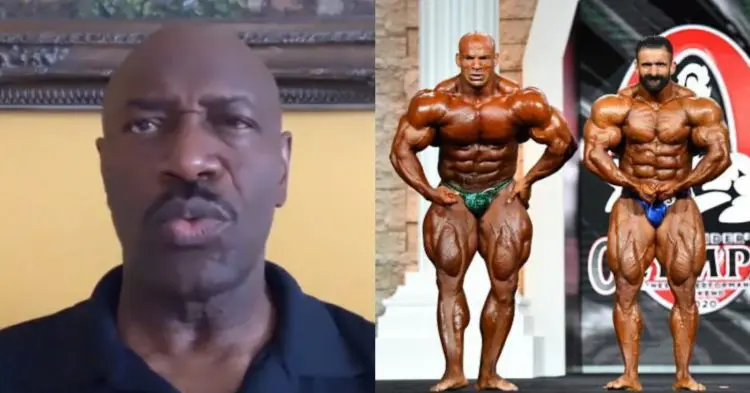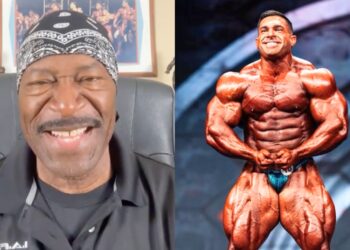With eight consecutive Mr. Olympia wins under his belt, Lee Haney is considered by many to be the greatest bodybuilder of all time. In a rare sit-down interview, he recently explained what it took for him to get to that point, and how he found his way to that record-setting amount of wins.
There are only a few people who can make the claim of being the GOAT of bodybuilding, and Haney is one of them. Despite the fact that he competed only until he was 31 years old, in that time he built up one of the best resumes in the sport, even to this day. He looked unstoppable in his run, winning eight straight Olympias, and as a result is referred to as a true legend in the sport.
With as incredible of a run as Lee Haney went on in his prime, and the fact that he has largely avoided any serious injuries like other bodybuilders of a similar caliber, there is always the question of how he was able to find such success. Lee is not one to sit down and do a ton of interviews, but he recently spoke with London Real for a good talk, and he touched a bit on how he changed the game in his prime. The way he explains it, he started off young, and was able to teach himself a lot of the diet and training techniques that worked for him, through trial and error.
“It was during an era where there was very little information out there,” Haney explained. “During that time, the magazines mainly consisted of training and nutrition. It wasn’t as commercialized as you see them now. So it was all about real, good quality knowledge. Another thing that was very good, growing up in my home town, you would find some of the older guys in the gym, and they would share with you some different training principles. ‘Okay, you want to do this, you don’t want to do that, that’s too much weight you’re using,’ and those kinds of tips and principles that were handed down through the generations, helped me to become the person that I am today, as far as my knowledge of training and knowledge of nutrition.
Get Fitter, FasterLevel Up Your Fitness: Join our 💪 strong community in Fitness Volt Newsletter. Get daily inspiration, expert-backed workouts, nutrition tips, the latest in strength sports, and the support you need to reach your goals. Subscribe for free!
“At the age of 11 years old, I asked my parents for a set of weights for Christmas, and they got them for me,” Haney continued. Inside that little package of weights, there was a Charles Atlas book that had the basic principles of training, mainly one exercise per body part. They were foundational exercises, and from those foundational exercises, everything else grew, but I stayed true to the principles that I had read there, which also matched up to the principles that were being given to me by the other senior weightlifters that I met.”
Looking Back On Lee’s First Bodybuilding Show
That being said, through the little bits of knowledge that he had gotten, Lee Haney began to experiment and discover what worked for him. At that point, he decided it was time to enter his first bodybuilding show. While he did not do very well, he says that this was a valuable learning experience for him, that he carried moving forward.
“I entered my first bodybuilding show when I was sixteen years old,” Haney said. “Did very well, didn’t win, didn’t place, but I was told by the judges that I had a lot of great potential. I continued to follow those principles, I learned as much as I could about nutrition through reading magazines. I grew up in the country where sweet potatoes and yams were a mainstay. So were pinto beans, so was corn, so was chicken, so was eggs, so all of the good quality nutrients were there from day one, just from growing up where I’m from. By implementing the training principles, good basic nutritional principles, I was able to imitate what I had read about, and my physique continued to grow and get better and better.
“A couple of years later, I entered the Mr. Palmetto, won the show at the age of eighteen,” Haney explained. “I beat guys that were in their 30’s and their 40’s. Then I went on to win the Mr. South, and again at age eighteen. Because of having great information, because of following very good nutritional guidelines, I was able to supersede guys that were older than me, because of my willingness and desire to follow the science that had been handed down to me by some of the legends of bodybuilding.”
The Legacy Of Lee Haney
It has been a long time since that first competition, and Lee Haney has gone on to accomplish a lot, and be an ambassador for the sport. Nowadays, in retirement, he looks to continue to inspire others with his story, and make the world a better place. He hopes that he can teach others the same types of good practices so that they can avoid long-term health problems, in the same way he has.
“We’re finite creatures, we’re not going to live forever,” Haney said. “If we can use what we accomplished over the span of our lifetime as a competitor, to impact the life of other young athletes, other people, then man, what a thrill to do so. That’s what’s so cool about the second half of the journey; being able to impact those younger athletes and point them in a direction of being successful at it. But also letting them know too, that this doesn’t last forever and you need to do it in such a way that you don’t destroy your physical body. At the end of the day, you still want to be functional. You want to enjoy your grandkids as I am.
“Your health is your wealth, and you want that at the end of the day.”
Today’s Generation Lacks Quality
There can be no denying the fact that this current generation of athletes is very different from the one that Lee Haney competed with when he was champion. In his mind, today’s bodybuilders overtrain and end up hurting themselves in the long run. Not only that, but he feels that while the size of the athletes has gone up, the actual quality of the bodybuilders has declined.
“The lack of the proper training principles has caused the physiques of today to be bigger, but lack quality,” Haney explained. “You see, a lot of guys look like mutants. With Dorian (Yates), of course he was a mass monster, and then as you saw Ronnie (Coleman’s) mass, and Jay Cutler, you still didn’t look like a mutant. Things were still proportioned. It was larger, but Dorian’s physique still had symmetry and balance to it.
“That’s what you don’t see now,” Haney added. “You see guys with little calves and big thighs. You see a guy with huge shoulders, but be a narrow width or high lats, because the ability and tools and the knowledge to develop a complete physique, with everything where it’s supposed to be…are not there in the training principles that we adhered to, growing up. Totally different.”
What do you think of this insight from the legendary Lee Haney?










Mr. Haney is right. Mr. Haney is always right. And if I thought otherwise, you don’t think that I would tell Mr. Haney that, do you? I am often foolish, but I am not a fool.